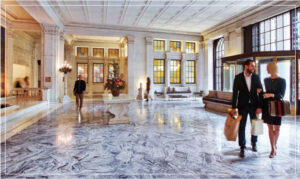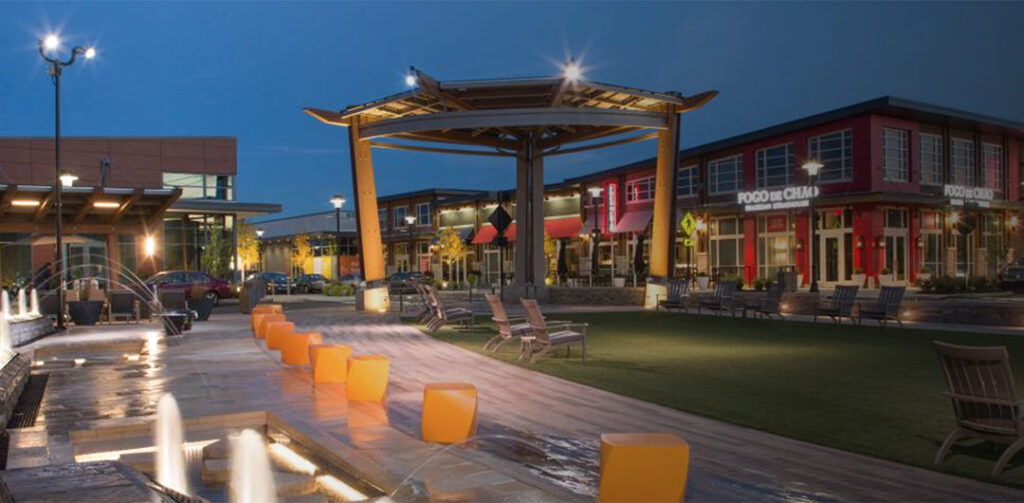The mixed-use mantra of “live, work, play” continues to drive development and redevelopment across the commercial real estate markets of Philadelphia.
Growing urban and suburban population density is a major factor, but changing attitudes also figure prominently: Members of the Millennial and Gen Z generations tend to look askance at living in single-family housing developments with mind-numbing commutes. Meanwhile, older Americans have shown a strong propensity to downsize and seek more adventurous lifestyles once the kids head off to college. Little wonder a study by the National Association of Realtors found that a majority of Americans—53 percent—prefer to live in “walkable communities.”
Initially, the net effect of this shift was a sizable migration to mixed-use developments in downtown areas. According to the Census Bureau, in 2006 the city of Philadelphia’s population started to grow again for the first time in half a century. Nearly all of that growth happened in and around the Center City, according to the Urban Land Institute.

More recent beneficiaries of the urban influx include the likes of Lyndon at The Curtis, located next door to Washington Square Park and Independence Mall at 170 South 6th St. With a total of 63 luxury apartments, the residences feature “art deco-inspired light fixtures, tall windows, and sleek floors,” writes a reviewer on Curbed. The apartments are part of the former headquarters of Curtis Publishing—a century-old building that Keystone Property Group has transformed into The Curtis, a mixed-use destination with offices, high-end stores and the likes of P.J. Clarke’s Restaurant and Bar, and Cooperage Whiskey and Wine Bar.
A showcase of architecture and design, the building was the former workplace of none other than American artist Norman Rockwell. Its 6th street entrance opens onto the 750-square-foot “Dream Garden” glass-mosaic mural by Maxfield Parrish and Louis Comfort Tiffany. The building’s 12-story atrium “is one of the great public spaces in the city,” Keystone says.
Mixed-Use Placemaking in the Philadelphia Suburbs
The Curtis could hardly be more urban, but live-work-play is no longer synonymous with in-town living—it is coming to the suburbs in major way.
Start with the July 2016 launch of 260,000-square-foot King of Prussia Town Center. Unlike the walkable, town center-style projects in Collegeville, Warrington and Saucon Valley, this large-scale retail property is ringed by residential, including Canvas, an empty-nester haven for people 55 and over. Bisnow describes KOP Town Center as “a true urban node in the suburbs around which a mixed-use community is coalescing.” It’s quite a change for a suburb long associated with industrial development and the King of Prussia Mall. KOP Town Center is packed with food-and-beverage tenants, including Fogo de Chão, Duck Donuts, District Taco, The Habit Burger Grill, Starbucks, Vitality Bowl Superfood Café and Davio’s Galleria. Among the retailers and service tenants are Hair Cuttery, Nordstrom Rack, Pearle Vision, REI, ULTA Beauty, Williams-Sonoma and SmileDirectClub, to name a few.
In Conshohocken, meanwhile, SORA West will offer a 165-key hotel with lots of restaurant space as well as a rooftop lounge. The developer, Keystone, aims to transform the 139-year-old Conshohocken Firehouse into a gastropub with indoor and outdoor areas. SORA West will also offer a 1,500-space parking structure and a central plaza for events and community gatherings. (At the time of this writing, the governor had reportedly authorized a waiver for construction to continue on SORA West, with social-distancing and other safety measures in place.)
In addition to ground-up development of mixed-use projects, developers are also courting non-retail uses in a bid to bring elements of live-work-play to traditional malls. At Neshaminy Mall in Bensalem, the new owners of the vacated, 211,000-square-foot Macy’s space (and a total of 16 acres at the property) reportedly aim to add office along with a mix of smaller stores, restaurants, service and entertainment tenants, some of them exterior-facing. The former Macy’s space got its start back in 1968 as Strawbridge’s.
The former Mall at Granite Run in Delaware County is now a mixed-use development called The Promenade at Granite Run. It integrates 400 luxury apartments with 830,000 square feet of retail, restaurants and entertainment. Tenants include TJ Maxx, Michael’s, Boscov’s, Sears, Kohl’s, Edge Fitness and Acme Supermarket. Both the Chester County lifestyle center Main Street at Exton and the Exton Mall are also adding residential, and the Oxford Valley Mall in Middleton Township also has a mixed-use redevelopment plan.
Keys to Successful Mixed-Use Projects
The success of a mixed-use project depends on a wide array of factors. Proximity to transit, for example, can make a huge difference. According to an analysis by the Center for Transit-Oriented Development, by 2030 about a quarter of all Americans will want their housing to be located near transit. The classic TOD is a mixed-use property situated right over a train station. It’s why the expansion of the Norristown High-Speed Line, which will bolster transportation between King of Prussia, Norristown and Center City Philadelphia, could be such a boon to mixed-use development for these areas. The $1 billion project, now under construction, is slated for completion in 2023.
Other factors are also important. At Equity Retail Brokers, we take a comprehensive, data-driven approach to assisting retailers in their site-selection decisions. We understand the critical need to thoroughly assess the trade area based on criteria such as population density, income and proximity to competitors. We also look carefully at site-specific traffic patterns, access and consumer behavioral patterns, among others.
Townships, though, are often such big fans of mixed use that they require residential developers to incorporate retailers into new projects without first running the appropriate market analysis. Unfortunately, the first-floor retail often performs poorly at these projects as a direct result. The lesson here is that you cannot just assume that having apartments will translate into adequate traffic and sales for retailers. Nor can you count on robust traffic from locals when you put first-floor retail into internal mixed-use projects that, after all, lack any visibility to main roads. The mixed-use conversion of Echelon Mall in Vorhees, N.J., is one example of a project in which local officials reportedly were bullish about bringing in non-retail uses. Critics see it as a forced attempt with poor long-term prospects.
Along the same lines, some of the early mixed-use properties were built without large-enough parking fields. As a result, theaters, bars and restaurants suffered from lackluster foot traffic. Where substantial retail is viable, the mix also needs to be just right: You want a blend of service tenants, fitness studios and entertainment, along with vibrant shops and restaurants. It’s a mistake to tenant the retail portion of a mixed-use center as though it were no different than a mall. You have to consider the varying needs of all users, from residents and locals, to office workers and hotel guests.
Fortunately, brokers, developers and investors have learned valuable lessons about how to partner on these projects to make it all click. They understand the importance of creating spaces between buildings that are colorful, fun and Instagram-friendly. Gone are the days when a few fountains and some shrubbery could be just nice enough to pass muster. The design firm Gensler puts it this way:
The key to injecting a mixed-use development with soul lies in providing a sense of wonder and delight, which can be accomplished through special events, intriguing public art, statement architecture, and the right mix of programming. Get it right, and people will linger.
In the future, we may also see more physical changes related to ecommerce and the sharing economy. The Covid-19 crisis has hammered home that delivery, whether from DoorDash, The Home Depot or Giant Food, is likely to grow with time, and this may require some tweaks to mixed-use developments. As noted by Gensler, these days “everything is on-demand, thanks to instant downloads and next-day delivery.” By being so convenient and offering so much all in one place, good mixed-use developments dovetail perfectly with these trends. “This alignment with today’s expectations and lifestyle,” writes the firm, “will continue to spur mixed-use moving forward.”
For more information, please contact us.
